Introduction
In the ever-evolving world of software development, maintaining a clean and efficient codebase is paramount. As software systems grow and become more complex, the need to refine and optimize code without altering its functionality becomes increasingly crucial. This process, known as refactoring, aims to enhance the internal structure of the code, making it more comprehensible, maintainable, and extensible.
Through the elimination of redundancies, improvement of code clarity, and optimization of performance, refactoring ensures that the code remains robust and adaptable to future changes. This article delves into the nuances of refactoring, exploring its significance, benefits, common misconceptions, and best practices, while highlighting the essential role it plays in achieving maximum efficiency and productivity in software development.
What is Refactoring?
Refactoring is the method of restructuring existing computer programs without altering their external behavior. The primary objective is to enhance the internal structure of the program, thereby making it more comprehensible, maintainable, and extensible. This practice involves eliminating redundancies, improving clarity, and optimizing performance while ensuring that the functional aspects remain unchanged.
One of the important benefits of refactoring is the streamlining of programming, which is essential for large software systems that tend to become cumbersome as the years pass. Streamlined programming requires less duration and effort to understand and alter, which is especially advantageous as developers frequently invest more duration reading programs than creating them. For example, the Code Red study emphasizes that tasks can require up to ten times longer to execute in poor quality software compared to well-kept software, highlighting the business risk linked to ignoring software health.
Additionally, program restructuring plays an essential part in ensuring software durability. Over time, even the most well-intentioned codebases accumulate technical debt, making them increasingly difficult to work with. By focusing on restructuring, developers can enhance programs to operate more effectively, which not only improves performance but also lowers operational expenses, particularly for extensive deployments. This is clear in practical examples where restructuring has allowed the application of more efficient algorithms and minimized unnecessary calls.
The process also significantly enhances the readability and maintainability of the codebase, making it easier to update, debug, and fix bugs. This enhancement in programming quality directly contributes to increased developer productivity and better software performance. As mentioned by specialists, restructuring is an essential phase in software creation that assists in keeping the programming clean, efficient, and simple to manage.
In summary, refactoring is an essential practice in modern software development, aimed at enhancing quality and maintainability while ensuring optimal performance and long-term sustainability.
Why Refactor Code?
Refactoring is crucial for maintaining a healthy codebase. Over time, as new features are added and changes are made, the programming can become convoluted and difficult to navigate. Refactoring aids in simplifying intricate programming, enhancing its readability and manageability. By reorganizing scripts to adhere to optimal standards, programmers can improve teamwork and lessen the chances of errors and technical liabilities. This practice not only makes future changes easier to implement but also improves the overall performance and scalability of the codebase. In fact, studies show that working with unhealthy software can take up to ten times longer compared to healthy software, putting businesses at risk. Therefore, continuous refactoring is essential to ensure efficient and scalable software development.
Benefits of Refactoring
Refactoring offers numerous benefits that significantly enhance the software development process. Firstly, it enhances the quality of the programming by making it cleaner and more organized, which simplifies updates and modifications. This is essential as clean and well-organized programming leads to enhanced maintainability and readability. For instance, a recent project demonstrated the effectiveness of restructuring by organizing global variables, removing dead code, and introducing a test function, which collectively improved the code's manageability.
Secondly, refactoring contributes to long-term development speed. A well-organized codebase is simpler to explore and utilize, decreasing the duration needed to introduce new features or resolve problems. Empirical data supports this, demonstrating that tasks can take up to ten times longer in unhealthy programming compared to well-maintained programming. This emphasizes the business advantage of maintaining a healthy software foundation, as rivals with optimized systems can implement functionalities much faster.
Thirdly, the process of restructuring assists in recognizing and removing potential security weaknesses, ensuring a more robust application. By reorganizing and examining the software, developers can reveal concealed problems that may present security threats.
Finally, restructuring can result in improved performance by optimizing ineffective programming. Techniques such as extracting methods and composing methods enhance the structure, making it more efficient. This optimization not only boosts performance but also makes the codebase more resilient to future changes and improvements.
By following optimal methods and utilizing resources such as AI-based models for program migration, developers can enhance the advantages of restructuring. As emphasized by specialists, grasping the methods and best practices for restructuring guarantees that the code stays tidy, efficient, and simple to maintain.
Common Misconceptions About Refactoring
Misconceptions about code improvement abound, often leading to hesitations and misunderstandings. One prevalent myth is that code improvement is only necessary for large projects. In reality, even small codebases can significantly benefit from regular improvements. Consistent upkeep assists in averting the buildup of technical debt, making certain the programming remains tidy and efficient. Another prevalent misunderstanding is that restructuring is equivalent to rewriting software. While both processes aim to improve quality, refactoring focuses on modifying existing elements to enhance their structure and readability without starting from scratch.
Refactoring can lead to improved readability, maintainability, and extensibility of the codebase. Well-structured and organized programming is easier to test, maintain, and upgrade, reducing the likelihood of bugs. For instance, breaking down large segments into smaller, more manageable parts can make the structure easier to understand and follow.
However, restructuring is not without risks. It involves changing a working system, which can inadvertently introduce new issues or affect other parts of the system. According to a Code Red study, tasks can take up to an order of magnitude longer when working with unhealthy software compared to healthy software. This demonstrates the critical business advantage of maintaining a healthy codebase.
To mitigate these risks, developers should use a suite of tests to identify errors quickly. 'As mentioned in literature about restructuring code, having tests in place ensures that any changes made during restructuring do not break existing functionality.'. This is crucial for maintaining the stability of the codebase while making improvements.
In summary, although restructuring may appear intimidating, it is a vital practice for preserving software quality. By dispelling myths and understanding the true benefits and risks, developers can approach refactoring with confidence and ensure their work remains robust and efficient.
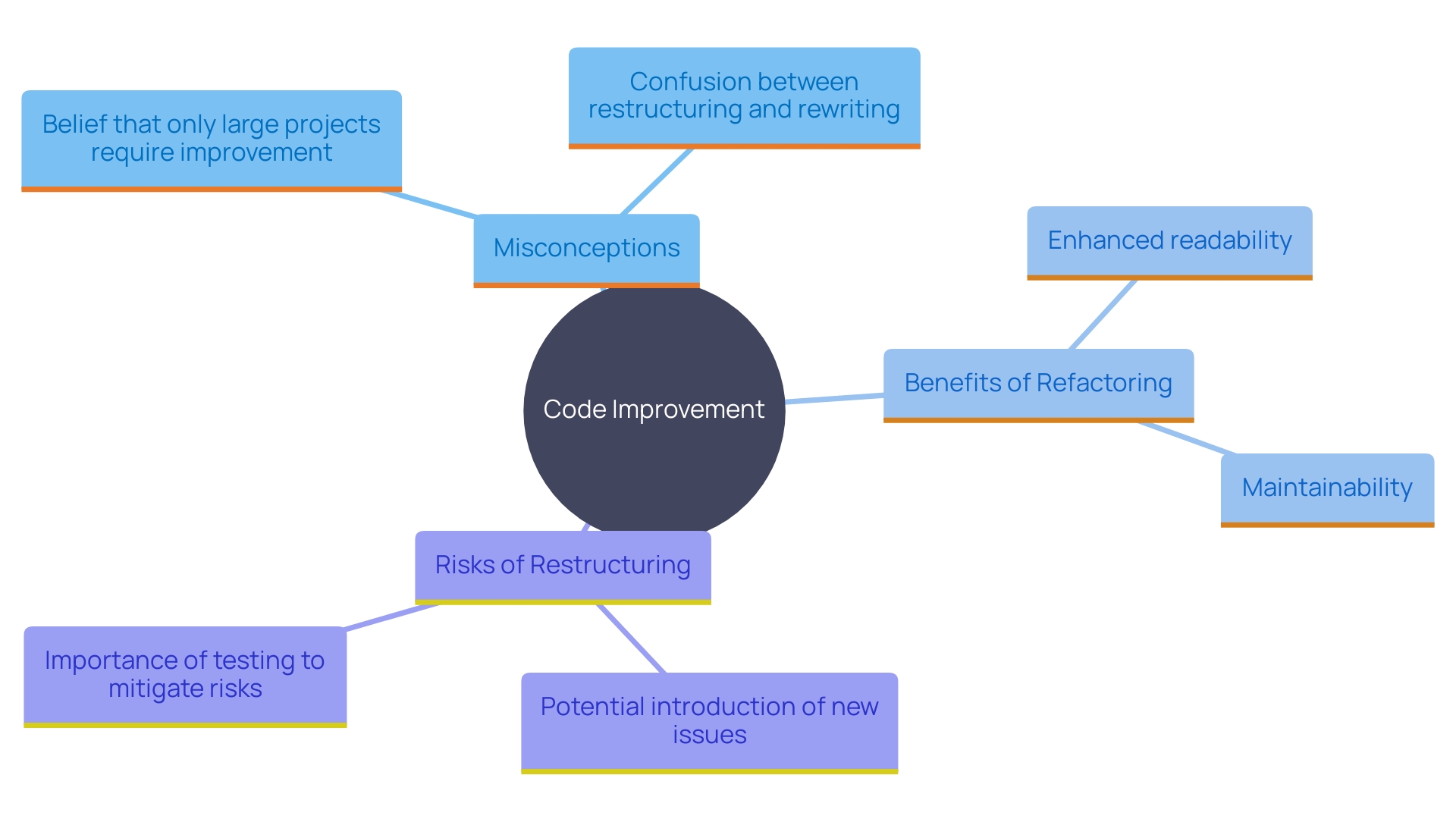
Types of Refactoring
Refactoring encompasses a variety of techniques aimed at improving the design and structure of software without altering its behavior. Key methods include simplifying complex methods, breaking down large classes into more manageable ones, and renaming variables and functions for clarity. These practices fall under system consolidation, method extraction, and class separation, each serving a distinct purpose in enhancing quality and readability.
Method extraction, often called the 'Swiss army knife' of refactorings, is widely acknowledged for its ability to enhance quality by isolating reusable segments. This method not only streamlines the programming but also enhances its maintainability. As one study highlights, the Extract Method refactoring is essential for collecting actionable insights and enhancing the clarity of the program.
Class separation is another crucial technique. By dividing large classes into smaller ones, developers can achieve better organization and reduce the likelihood of bugs. This practice aligns with modern coding standards, such as switching to ES6 imports, which improves compatibility and makes future changes easier to implement.
Consolidation of scripts involves merging similar segments to eliminate redundancy and enhance maintainability. This is especially important in large software repositories where duplicated elements can lead to maintenance challenges and increased technical debt. For instance, Google's use of machine learning models to adapt and validate changes during migrations significantly reduces the time spent on reviews, allowing engineers to focus on more creative tasks.
Supporting these practices with empirical data, the Code Health metric demonstrates the business advantages of a well-maintained codebase. Tasks can take significantly longer in unhealthy programming, putting businesses at risk. For example, implementing a feature in poor-quality programming might take nine months, whereas competitors with clean practices can accomplish the same task in less than a month.
In summary, restructuring methods such as method extraction, class separation, and consolidation are essential for enhancing the quality and clarity of programming. These practices not only enhance maintainability but also offer substantial business benefits by reducing development time and facilitating easier future modifications.
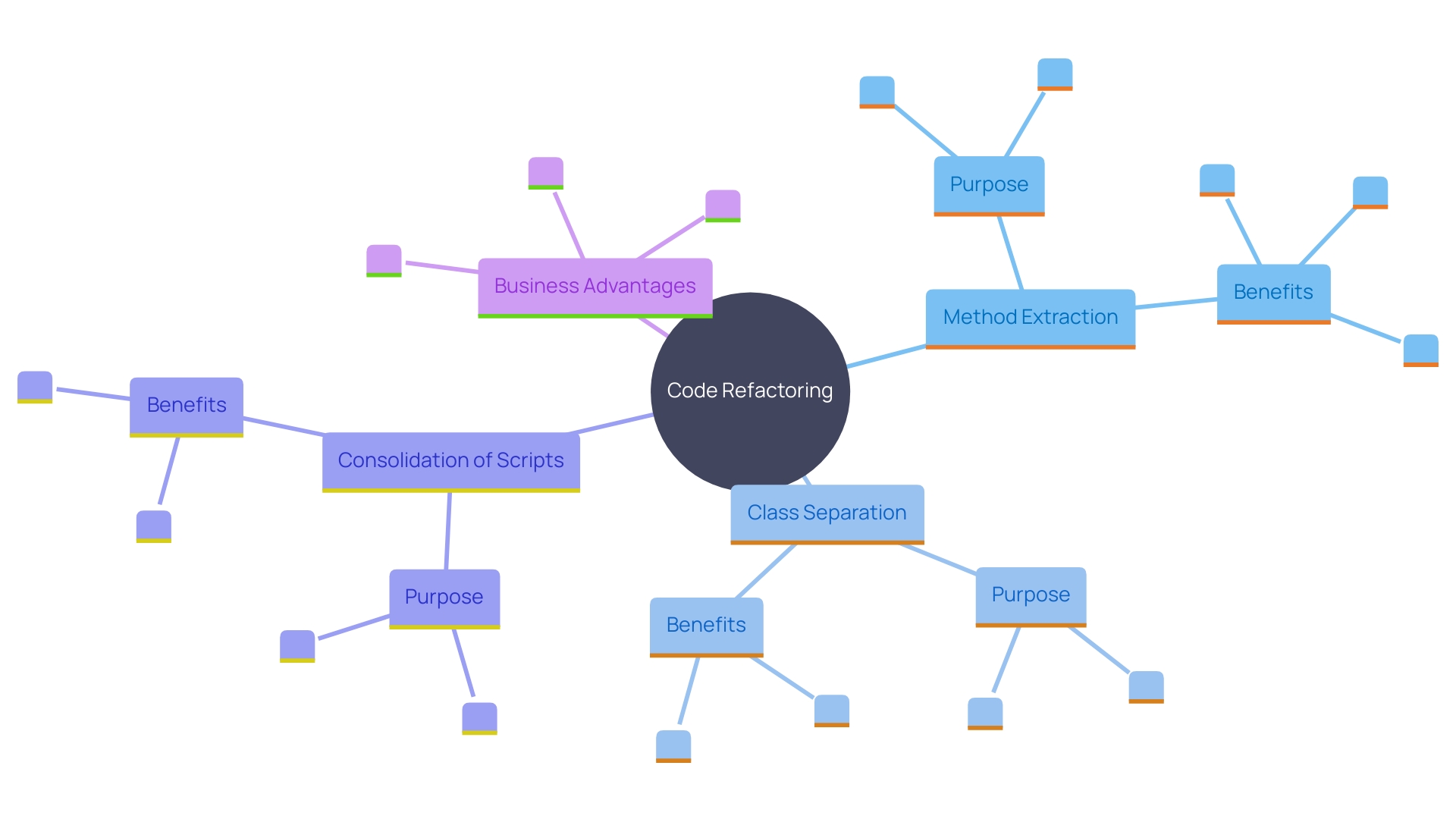
When to Refactor
Refactoring should be an integral part of the development process, especially in specific scenarios that demand immediate attention. For instance, after implementing new features, it's essential to refactor to ensure that the added functionalities integrate seamlessly and do not introduce technical debt. Facing a bug is another crucial scenario where restructuring proves advantageous; it not only resolves the immediate problem but also helps avoid similar bugs from happening later by enhancing the system's organization and clarity.
During reviews of the program, revising can improve quality significantly. It's a prime opportunity to identify and address potential issues early, ensuring that the system remains clean and maintainable. Furthermore, when the codebase becomes challenging to navigate or comprehend, it indicates an urgent necessity for restructuring. Streamlining the program in such situations can lessen the duration and effort needed to comprehend and alter it, ultimately enhancing the software development process.
Moreover, regularly scheduled intervals for refactoring can keep the codebase healthy and manageable. This proactive approach assists in maintaining software quality over time, reducing complexity, and making it easier to test and upgrade. Well-structured programming minimizes the chances of bugs hiding within and facilitates better test coverage, ensuring that the software remains robust and reliable.
Refactoring can also enable access to new libraries and dependencies, unlocking better efficiency and capabilities for the program. By continuously improving and simplifying the programming, developers can ensure it remains adaptable and scalable, paving the way for future enhancements without the burden of technical debt.
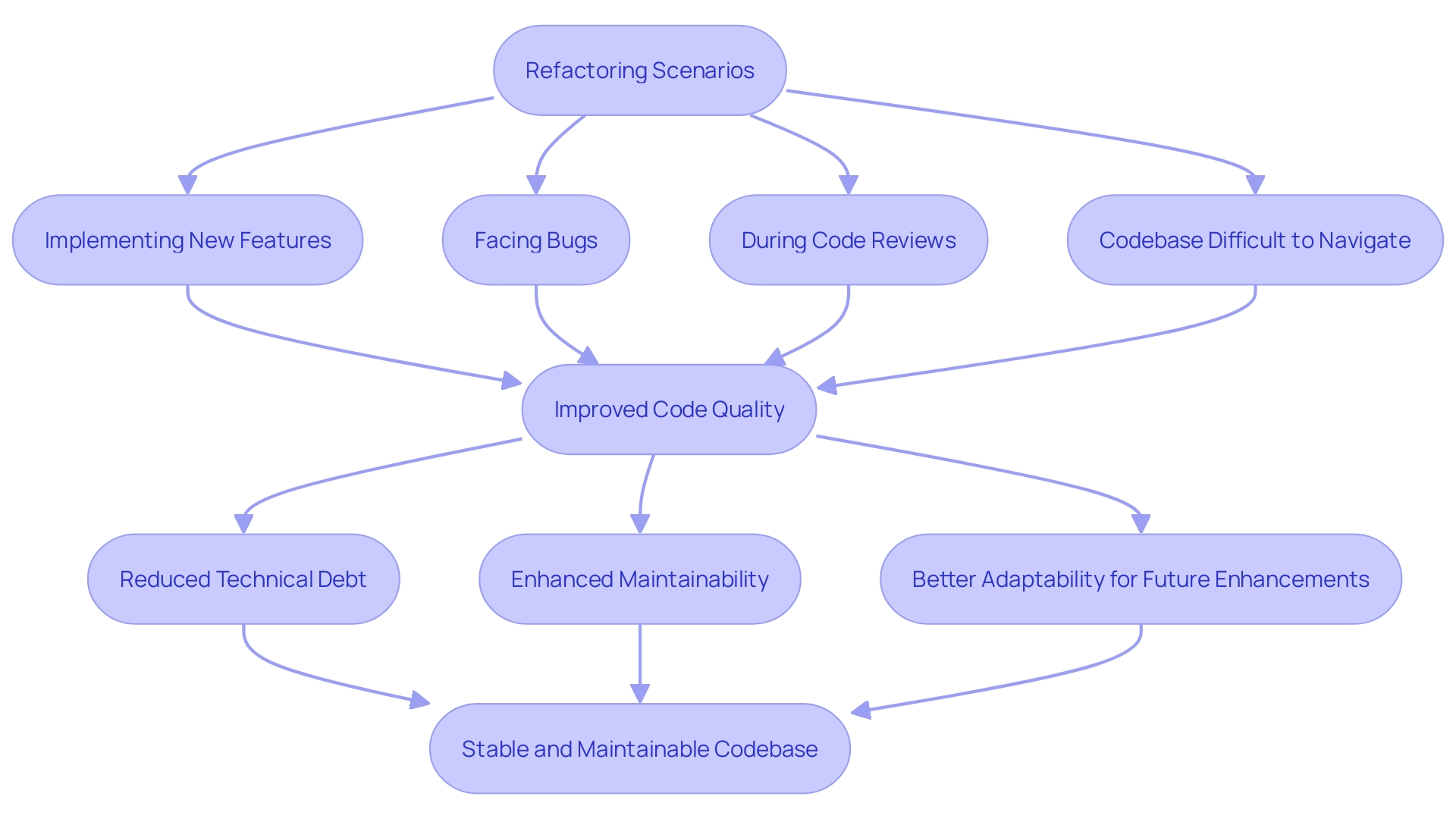
How to Refactor
Effective refactoring requires a systematic approach to enhance the readability and maintainability of the software. Begin by recognizing aspects that require enhancement, which is essential in extensive software systems where programming can become unwieldy over the years. Prioritize these areas based on their impact and complexity. This helps streamline the process and ensures that the most critical issues are addressed first, reducing the overall time and effort required.
Implement changes gradually and test thoroughly after each modification to maintain the system's functionality. This step is essential to avoid introducing new bugs, especially in brittle areas with low test coverage. Utilizing version control systems is pivotal for tracking changes and facilitating collaboration among team members. This not only helps in maintaining a record of modifications but also makes future changes easier to implement.
Refactoring simplifies the programming structure, making it easier to read, understand, and maintain. This is especially significant as developers allocate more time to reviewing instructions than creating them. Simplified programming reduces the complexity and makes it harder for bugs to hide, leading to more efficient testing, maintenance, and upgrades. Moreover, well-structured and organized programming is less prone to future errors, and any that do arise will be easier to identify and fix.
In recent developments, the Extract Method transformation is highlighted as a key technique, often referred to as the "Swiss army knife" of transformations. Research indicates that 38.6% of Extract Method restructuring efforts concentrate on tackling duplicate segments, which greatly enhances software quality. By adopting these systematic approaches and utilizing the right tools, developers can make their codebases more robust and adaptable to future changes.
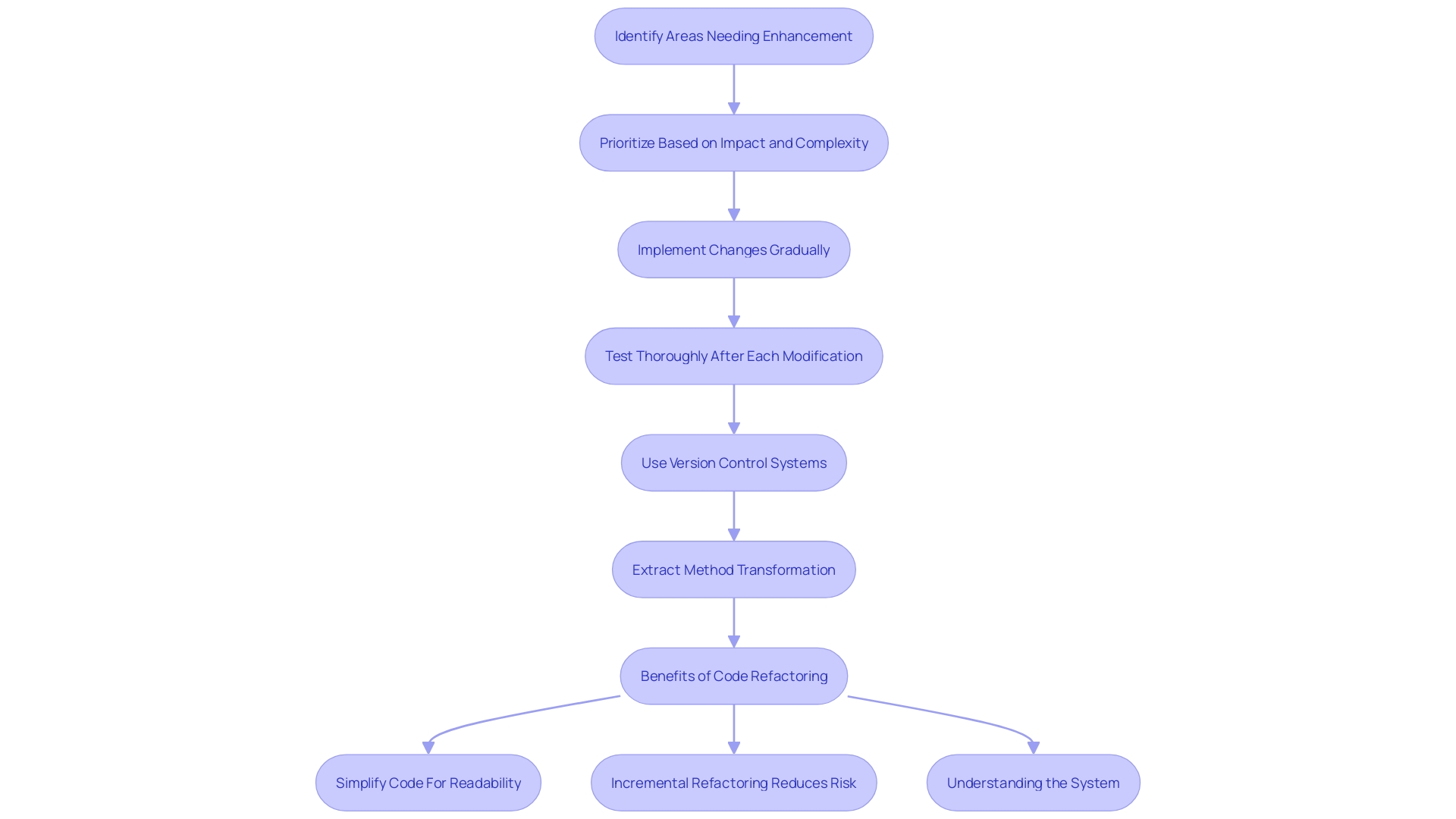
Best Practices for Refactoring
'To achieve the full benefits of restructuring, adhere to best practices which include keeping changes small and manageable, maintaining comprehensive test coverage, and documenting changes for future reference.'. Refactoring should be an integral part of the development cycle, ensuring that the program remains clean, efficient, and easy to maintain.
Refactoring can be approached in several ways, such as during peer reviews or at regularly scheduled intervals. 'Peer evaluations assist in spotting and resolving possible programming problems early, while routine upkeep adjustments maintain the software in prime condition.'. This dual approach not only simplifies the code but also significantly reduces technical debt, making future changes easier to implement.
Thorough test coverage is essential during code restructuring. As emphasized by experts, “If you don’t have a suite of tests, you won’t know when (not if) you break something.” This is particularly important when dealing with large codebases where the risk of introducing bugs is higher. Proper testing ensures that any refactoring efforts do not inadvertently introduce new issues.
Empirical data also supports the importance of maintaining a high software health score. Research indicates a non-linear relationship between software quality and business impact, suggesting that healthier software significantly enhances productivity and minimizes the time needed for future developments.
By understanding and implementing these best practices, developers can ensure that their refactoring efforts lead to cleaner, more maintainable code, ultimately driving efficiency and productivity in software development.
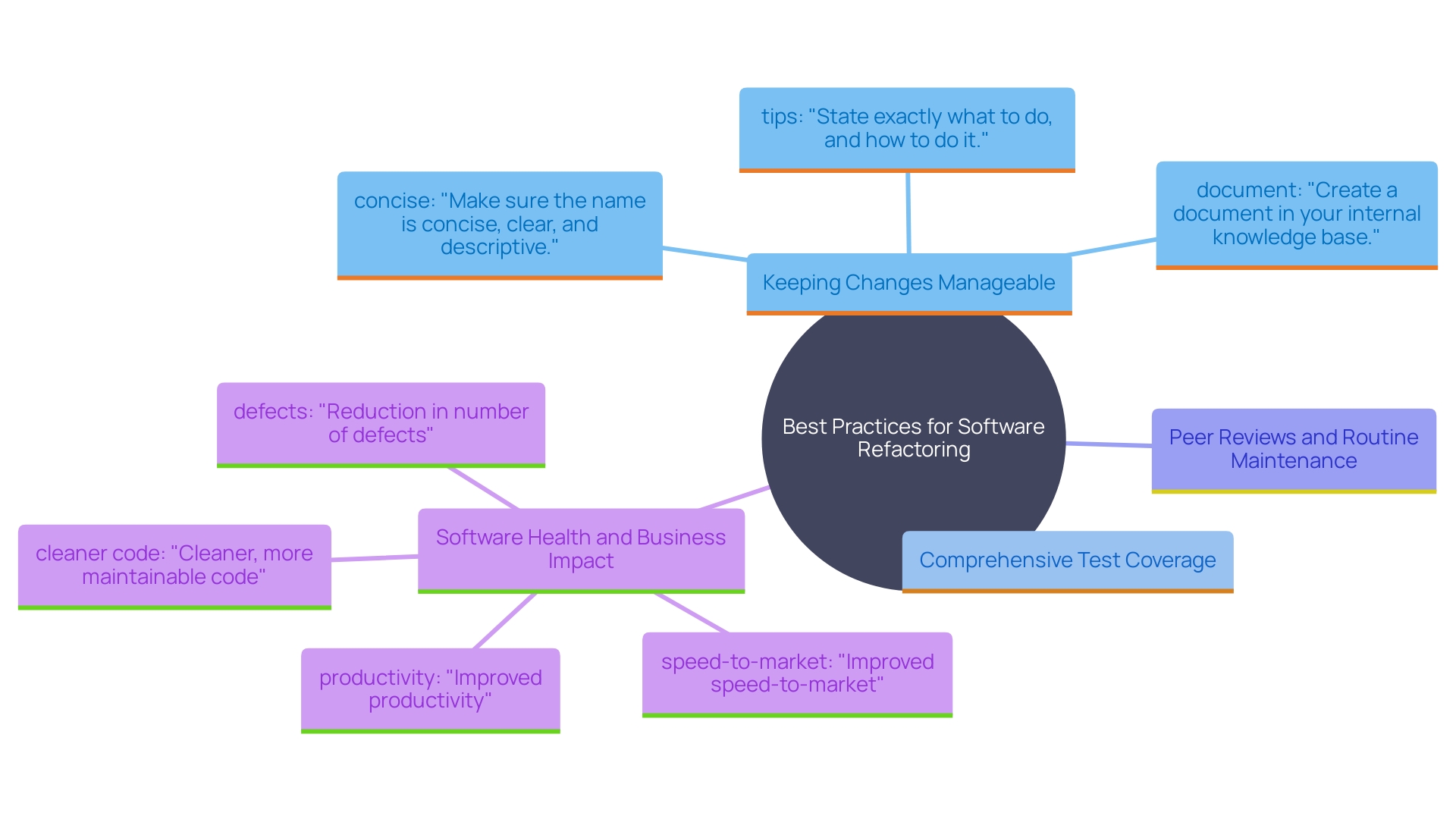
Conclusion
Refactoring is a vital practice within software development that significantly enhances code quality and maintainability. By restructuring existing code without altering its external behavior, developers can simplify complex code, improve readability, and eliminate redundancies. These benefits are crucial in maintaining a healthy codebase, especially as software systems evolve and accumulate technical debt over time.
The advantages of refactoring extend beyond mere code cleanliness. It contributes to long-term development speed, enabling faster implementation of new features and efficient debugging. Studies indicate that working with well-maintained code can drastically reduce the time required for tasks, providing a competitive edge in the fast-paced tech landscape.
Additionally, refactoring aids in identifying security vulnerabilities, ensuring a more robust application and optimizing performance through the refinement of inefficient code.
Despite common misconceptions about the necessity and scope of refactoring, it is clear that regular maintenance is essential for any codebase, regardless of size. By dispelling myths and recognizing the true benefits, developers can approach refactoring with confidence. It is imperative to integrate refactoring into the development process, utilizing systematic methods and best practices to ensure ongoing code health.
This proactive approach not only enhances the quality of software but also fosters greater efficiency and productivity, ultimately leading to more successful software development outcomes.
Frequently Asked Questions
What is refactoring?
Refactoring is the process of restructuring existing computer programs without changing their external behavior. The goal is to improve the internal structure, making the code more understandable, maintainable, and extensible.
Why is refactoring important?
Refactoring is crucial for maintaining a healthy codebase. Over time, as code evolves with new features and changes, it can become convoluted. Regular refactoring simplifies complex code, enhances readability, and reduces technical debt, ultimately leading to improved performance and scalability.
What are the benefits of refactoring?
Refactoring offers multiple benefits, including improved code quality by making it cleaner and more organized, enhanced maintainability and readability, increased development speed, identification and removal of potential security vulnerabilities, and improved performance through optimization of inefficient code.
What are some common techniques used in refactoring?
Common refactoring techniques include Method Extraction (isolating reusable segments of code), Class Separation (breaking down large classes into smaller ones), and Consolidation (merging similar code segments to eliminate redundancy).
Are there risks associated with refactoring?
Yes, refactoring carries risks, such as inadvertently introducing new issues or affecting other parts of the system. To mitigate these risks, it's important to have thorough testing in place to ensure that the functionality remains intact after modifications.
How does refactoring contribute to developer productivity?
By improving code quality and organization, refactoring reduces the time developers spend reading and understanding code, allowing them to focus more on creating new features. Studies have shown that working with well-maintained software can be significantly faster than with poorly maintained code.
When should refactoring be performed?
Refactoring should be performed regularly, especially after implementing new features, when bugs are found, or during code reviews. It is also beneficial to schedule regular refactoring intervals to maintain code quality over time.
How can developers ensure successful refactoring?
Developers can ensure successful refactoring by keeping changes small and manageable, maintaining comprehensive test coverage, documenting changes for future reference, and utilizing version control systems to track modifications.
What misconceptions exist about refactoring?
Common misconceptions include that refactoring is only necessary for large projects; in reality, even small codebases benefit from regular improvements, and that refactoring is the same as rewriting code; however, refactoring focuses on improving existing code without starting from scratch.
How can refactoring impact business performance?
Maintaining a healthy codebase through regular refactoring can significantly enhance productivity and reduce the time required for future developments, thereby providing a competitive edge in the market.




